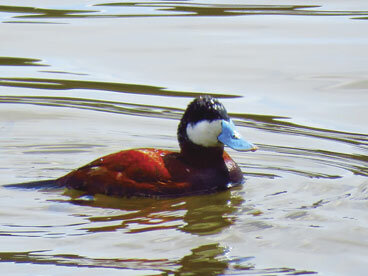
Photo courtesy Charles Martinez
This week’s Bird of the Week, compliments of the Weminuche Audubon Society and Audubon Rockies, is the ruddy duck.
With its oversized, stiff tail sticking straight up, this small duck can be readily identified on the water. In breeding plumage, the colorful male’s bright white cheek patch, sky blue bill and chestnut-colored body stand out. The female, brown overall, has the same short-necked, compact profile and large, scoop-shaped bill.
During the day, when not motoring across the water, tightly grouped flocks may sleep with heads tucked and look like grayish or chestnut saucers floating on the surface.
This is another duck nearly helpless on land but skilled at diving, using its large feet to propel itself through the water. Feeding on aquatic insects and other invertebrates, ruddy ducks dive to the bottom of a lake or pond to scoop up a mouthful of mud. Projections inside their large bills allow them to filter out and eat prey, and discard the rest. They also feed on a variety of aquatic plants and their seeds.
Unlike most ducks, ruddy ducks do not form pairs until after arriving on the breeding grounds. The male’s courtship display involves rapidly striking his bill against his inflated neck which forms bubbles in the water and ends in a call described as “belch-like.” Female ruddies apparently find it appealing.
Relative to their small size, females lay the largest eggs of all ducks. They are not fussy where they leave them, depositing them also in the nests of other ruddies and unrelated duck species. The large egg size results in hatchlings that are well-developed and require little care.
Although the ruddy duck breeding range does extend into Colorado, it is estimated that over 85 percent breed in the prairie pothole region of south-central Canada and north-central United States. These depressions, created when ice-age glaciers receded, are now important wetland areas that fill with snowmelt and rain in the spring. According to Ducks Unlimited, this region is the “most important habitat for breeding waterfowl in the world.”
For information on events, visit www.weminucheaudubon.org and www.facebook.com/weminucheaudubon/.